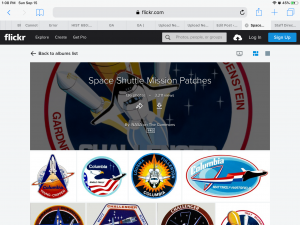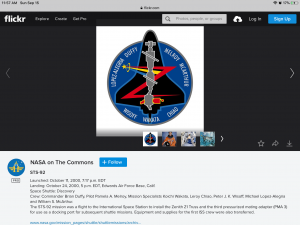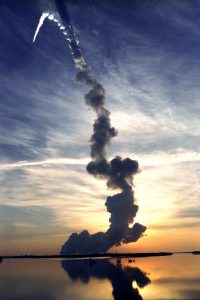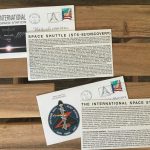Visiting the NASA on The Commons on Flickr online platform takes me back on love memory lane, working as an undergraduate co-op at Cape Canaveral. It’s not my first time discovering this awesome venue hosted by Flickr, for my love affair with the Space Program has endured all these years, including my tenure as STEM librarian at an R1 institution. But now that I get to experience it within the context of Digital Humanities as a Humanities librarian, this is a chance for me to reconnect with this old flame of mine.
The NASA on The Commons Site
Through this latest browsing, I’ve come to realize that the NASA on The Commons page comprises six collections, each one with its multiple albums: Space Operations, Integrating Science, Art & Engineering , Astronauts, NASA People, Exploring our Universe, and The History of NASA.

Among the photographs I’m exploring through their search features, I stumbled upon a couple that marked a special day for me: the 100th Shuttle mission launch in the Fall of 2000. The album entitled “Space Shuttle Mission Patches”, for instance, contains the insignia for STS-92, one of the few launch missions I got to be part of.

I find myself looking back with wistful memories of the Space Shuttle Discovery on its 29th ascent to space, with official images of its insignia, crew members, and mission aspects. Some of these images can appear in more than one album of the NASA collections, which tells me that they are contextualized.
The Space Act Agreement for NASA Image Content
The About section of the NASA on the Commons platform, discusses the selective process through which NASA selected their images from the even more comprehensive platform NASA Images Web Site. The selected images brought to the Flickr Commons site based on their non-exclusive Space Act Agreement, which makes most of their photos non-copyrighted, hence the reason we see the phrase “no known copyright restrictions” below each image from this collection. This leads me to think that NASA images are in public domain.
Such agreement allows us to use this material for educational or informational purposes. For more information on these guidelines, visit HERE. NASA strictly stipulates that it should be acknowledged as the source of the image used, especially when used for commercial purposes.
I refrain from using the CC conventions, since NASA websites, including the Commons, do not stipulate CC policies for images as clearly as the European Space Agency , with its CC BY-SA license agreement.
Naming and Categorizing Conventions for NASA Images
An interesting aspect to focus our attention on while looking at a specific image is the description section below it, which tells us its categorization, naming and tagging of some of these image. For instance, you can tell the image STS-96 Launch (by the way, STS stands for Space Transportation System) is an official NASA photo the instance you see its assigned number SPD-MARSH-9903915.

The description also tells us this image appears in four albums belonging to one of the six NASA collections. Some of these pictures use effective tagging conventions, but I must say, that in the case of STS-96, its tagging is a bit out of control. Some of the tags will point us to other NASA official images, but by having 56 tags assigned here, I’m not sure how effective they can be.
Some point to the astronauts of this mission, the companies that were involved in the refurbishment of the Discovery shuttle, different aviation authorities, as well as the clouds that appear on the image. The proliferation of tags in this case, will likely take me to a path outside the NASA on the Commons realm. Simpler tags, such as “STS-96”, “Shuttle Discovery”, and “Shuttle Launch”, will probably keep me in the same orbit of NASA collections. One good example of a well-tagged image would be one of the STS-135 crew posing inside the Orbiter Processing Facility (OPS) which comes with us enough tags to describe it.
NASA Policy on “Free-Flowing” Discussion of Images
A particular related to NASA’s take on public interactions with these images is its policy on commenting and posting (found in the About section). It appears that, while they welcome the posting of comments and discussions, they encourage us to keep one main thing in mind: to stay on topic. When it comes to posting comments related to “decision-making and operational management” issues and specific individuals and politics involved, as long as we keep mere personal attacks off our statements, NASA will encourage healthy discussions from viewers.
This is just my latest love scene of the many I have had during my life-long love affair with the Space Program. A spark rekindled by the cupids inhabiting the Digital Humanities orbits, and the personal pictures I’ve included on this page.
Yep, this is me, back in 2000, working as part of the Structural Engineering team with the Boeing—Lockheed-Martin joint venture company, United Space Alliance. I’ve kept internal newsletters for employees involved in space missions, official cards with descriptions of the mission and the symbology behind each insignia, as well as patches and thermal protection components, such as section of blankets and tiles. Memories I’ve stored away, but brought back by the NASA on The Commons site.
And to keep our flame alive, I will accept NASA’s invitation to help tell the story of their collections.


